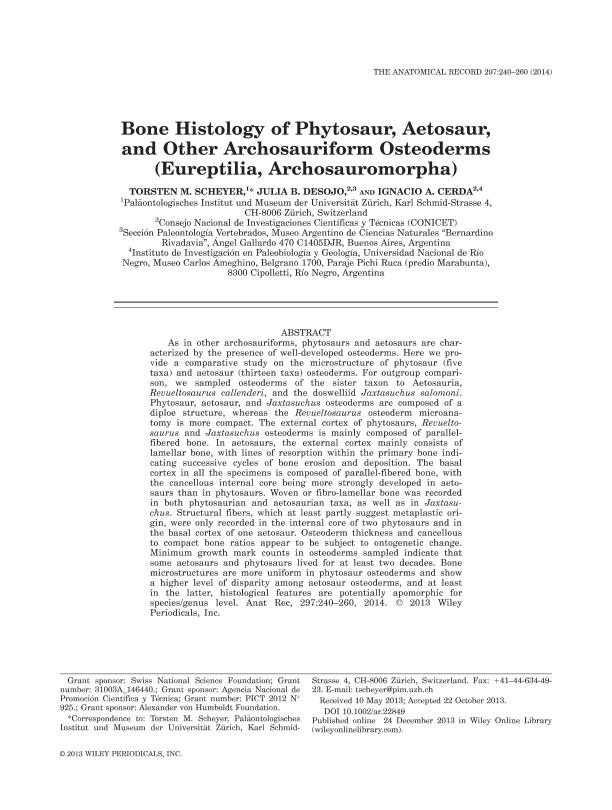Mostrar el registro sencillo del ítem
dc.contributor.author
Scheyer, Torsten M.
dc.contributor.author
Desojo, Julia Brenda

dc.contributor.author
Cerda, Ignacio Alejandro

dc.date.available
2017-01-27T21:02:22Z
dc.date.issued
2014-02
dc.identifier.citation
Scheyer, Torsten M.; Desojo, Julia Brenda; Cerda, Ignacio Alejandro; Bone histology of Phytosaur, Aetosaur, and other Archosauriform Osteoderms (Eureptilia, Archosauromorpha); Wiley; The anatomical Record; 297; 2; 2-2014; 240-260
dc.identifier.issn
1932-8494
dc.identifier.uri
http://hdl.handle.net/11336/12131
dc.description.abstract
As in other archosauriforms, phytosaurs and aetosaurs are characterized by the presence of well-developed osteoderms. Here we provide a comparative study on the microstructure of phytosaur (five taxa) and aetosaur (thirteen taxa) osteoderms. For outgroup comparison, we sampled osteoderms of the sister taxon to Aetosauria, Revueltosaurus callenderi, and the doswelliid Jaxtasuchus salomoni. Phytosaur, aetosaur, and Jaxtasuchus osteoderms are composed of a diploe structure, whereas the Revueltosaurus osteoderm microanatomy is more compact. The external cortex of phytosaurs, Revueltosaurus and Jaxtasuchus osteoderms is mainly composed of parallel-fibered bone. In aetosaurs, the external cortex mainly consists of lamellar bone, with lines of resorption within the primary bone indicating successive cycles of bone erosion and deposition. The basal cortex in all the specimens is composed of parallel-fibered bone, with the cancellous internal core being more strongly developed in aetosaurs than in phytosaurs. Woven or fibro-lamellar bone was recorded in both phytosaurian and aetosaurian taxa, as well as in Jaxtasuchus. Structural fibers, which at least partly suggest metaplastic origin, were only recorded in the internal core of two phytosaurs and in the basal cortex of one aetosaur. Osteoderm thickness and cancellous to compact bone ratios appear to be subject to ontogenetic change. Minimum growth mark counts in osteoderms sampled indicate that some aetosaurs and phytosaurs lived for at least two decades. Bone microstructures are more uniform in phytosaur osteoderms and show a higher level of disparity among aetosaur osteoderms, and at least in the latter, histological features are potentially apomorphic for species/genus level.
dc.format
application/pdf
dc.language.iso
eng
dc.publisher
Wiley

dc.rights
info:eu-repo/semantics/openAccess
dc.rights.uri
https://creativecommons.org/licenses/by-nc-sa/2.5/ar/
dc.subject
Bone Microstructure
dc.subject
Dermal Armor
dc.subject
Phytosauria
dc.subject
Aetosauria
dc.subject.classification
Paleontología

dc.subject.classification
Ciencias de la Tierra y relacionadas con el Medio Ambiente

dc.subject.classification
CIENCIAS NATURALES Y EXACTAS

dc.title
Bone histology of Phytosaur, Aetosaur, and other Archosauriform Osteoderms (Eureptilia, Archosauromorpha)
dc.type
info:eu-repo/semantics/article
dc.type
info:ar-repo/semantics/artículo
dc.type
info:eu-repo/semantics/publishedVersion
dc.date.updated
2016-12-12T14:28:09Z
dc.journal.volume
297
dc.journal.number
2
dc.journal.pagination
240-260
dc.journal.pais
Estados Unidos

dc.journal.ciudad
Hoboken
dc.description.fil
Fil: Scheyer, Torsten M.. Paläontologisches Institut und Museum der Universität Zürich; Suiza
dc.description.fil
Fil: Desojo, Julia Brenda. Consejo Nacional de Investigaciones Científicas y Técnicas. Oficina de Coordinación Administrativa Parque Centenario. Museo Argentino de Ciencias Naturales; Argentina
dc.description.fil
Fil: Cerda, Ignacio Alejandro. Consejo Nacional de Investigaciones Científicas y Técnicas; Argentina. Universidad Nacional de Rio Negro. Sede Alto Valle. Instituto de Investigaciones en Paleobiologia y Geologia; Argentina
dc.journal.title
The anatomical Record
dc.relation.alternativeid
info:eu-repo/semantics/altIdentifier/doi/http://dx.doi.org/ 10.1002/ar.22849
dc.relation.alternativeid
info:eu-repo/semantics/altIdentifier/url/http://onlinelibrary.wiley.com/doi/10.1002/ar.22849/abstract
Archivos asociados
